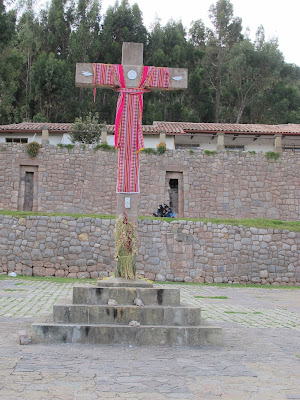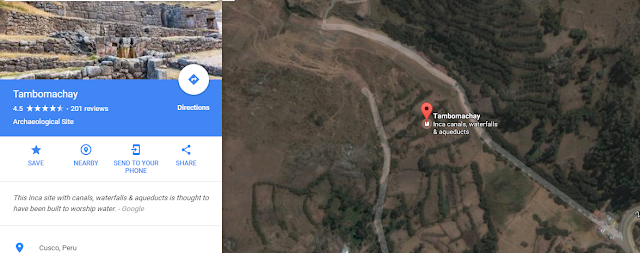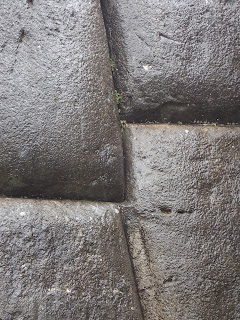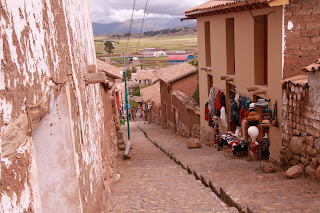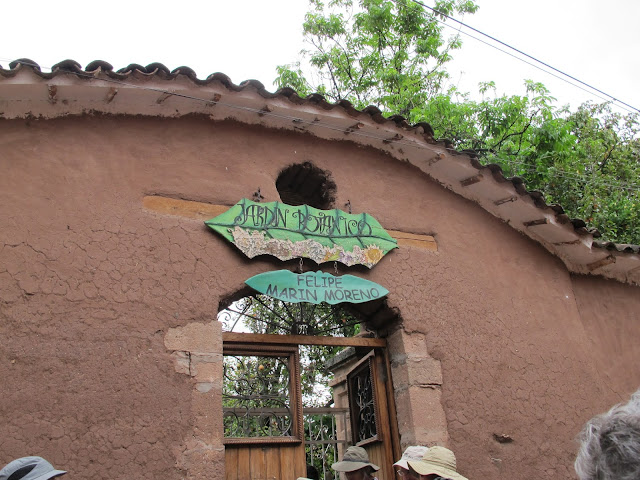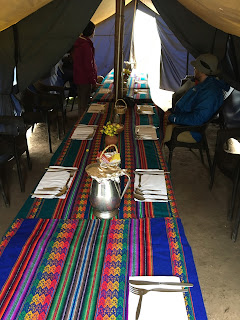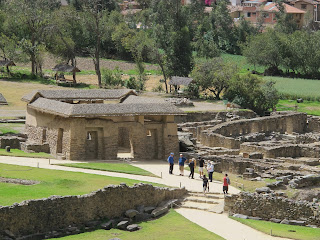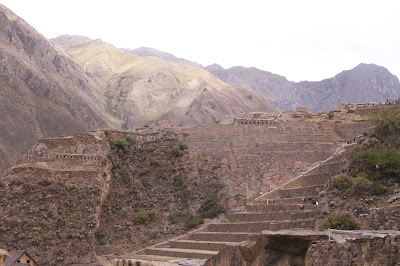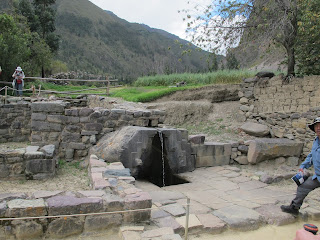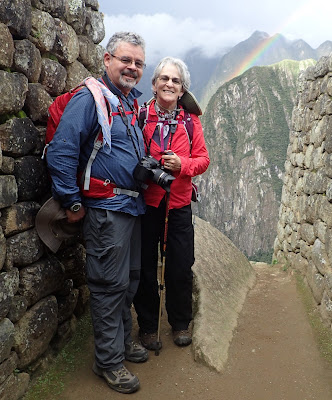As readers may have noticed based on the dates of our previous annual anniversary trips, our pattern has been to travel at the end of August or well into September. This year was my turn to select a location and make the arrangements. After visiting with friends who had recently returned from their visit to Peru made in late May last year, and thinking about all the miserably hot hikes we'd endured over previous summers to prepare for our other trips, Enrique and I decided that we'd tackle our next bucket list item - Machu Picchu - in late May, as well.
Early this Spring, we spent 2-3 days a week hiking longer and longer distances including treks into the Rincons or the Catalinas. When the temperatures started to soar, we began to drive up nearby Mt. Lemmon and hiked trails at 8-9000' elevation with plenty of ups and downs. We didn't realize it at the time, but the training we did hiking down proved to be very helpful, especially for our quads and knees, since at least two of our hikes included significant downhill sections as did the site at Ollantaytambo.
As has been our custom, we turned to our National Geographic Expeditions travel catalogues and found a variety of trips that would provide us with a visit to Machu Picchu (and even the Galapagos or the Amazon). We decided to go with the 10-day
Sacred Valley and Machu Picchu Adventure:
and Enrique created this map to illustrate our travels. We also want to thank Joelle H., a member of our traveling group, who prepared a list of each day's adventures working with lead guide, Manolo Lazo and guide Teddy Romero Mendoza. This generous gesture helped us organize our photos and especially figure out which ruins belonged to what day. Our guides were outstanding!
As we learned and you will see, although Machu Picchu is as beautiful and mysterious as we had heard, we visited many other jaw-dropping sites as well as two excellent museums and learned that the Incas were preceded by several other important cultures. Some believe that the earlier inhabitants created sites upon which the Incans built. I will be adding a separate post about the museum visits later. This image that lists the previous cultures was displayed in the
Museo Inkariy, a private collection housed in a fairly new building near Calca/Urubamba. (Click on the link - and others throughout the text of this post - for photos and information!)
Enrique and I, using our iPhones and three other cameras, managed to capture more than 1200 images. You'll be seeing only a small selection of those that we hope will introduce you to the wonders of what we saw and, if you've been thinking about making the trip, will encourage you to visit, as well. I am continuing to dig through our photos and add as well as identify structures we saw while at Machu Picchu. We've discovered a few websites that have helped us, too.
For those unaccustomed to this site, you can click on a photo and get a full screen image. Depending on your server, etc., you'll also see photo images at the bottom of your screen and you can simply scroll right (or left) and view the photos posted.
We flew to Dallas and a few hours later boarded our overnight flight to Lima where we landed in the early morning, cleared customs, walked from one area of the long terminal outside and back in to the domestic flight section, enjoyed breakfast and then boarded our 9 a.m. LATAM Airlines flight to Cusco where we were met by a Nat Geo representative and driven to our beautiful hotel, the Libertador Palacio del Inca, a remodeled mansion built on Inca walls that can be seen in various areas of the hotel including the bar. Immediately we became aware that the precise laying of the blocks was not limited to Machu Picchu.
 |
| view of the Andes from our window |
 |
| Notice the traffic light. Lights are either green or red. The number to the left of the light indicates how many seconds until the light turns color. We noticed that many drivers start to go before the light turns green. |
 |
| The main plaza - the Plaza de Armas - looking towards our hotel that is hidden behind the Inglesia Santo Domingo Qorikancha built over the remains of the Inca Temple of the Sun (the curved structure below the building). Found here are also the Temple of the Moon, Lightning, Thunder and Raindows. [Wikipedia offers an extraordinary photo of this scene - the lighting is much better: Iglesia Santo Domingo Qorikancha.] |
 |
| The interior courtyard of our hotel, the Palacio del Inka, a former hacienda |
 |
The huge buffet breakfast included honey from this honeycomb
|
 |
| After we'd unpacked and napped, we walked through the central Plaza |
 |
| The homes dotting the hillsides around Cusco lend a magical feeling to the evening |
 |
| The cathedral, built beginning in 1550, was hosting an anniversary celebration |
 |
| At the Limo for dinner where I enjoyed my first pisco sour |
 |
Dinner!
|
Late the next morning, after a hearty buffet breakfast, we headed out with the goal of visiting various sites as well as stretching our legs and becoming adjusted to the 10,913' (and higher) altitude. We had both been prescribed a medication to help us deal with the altitude and began taking the rx shortly before boarding our flight to Lima. My personal experience was that the medication altered my electrolyte balance and I stopped taking it a few days later once I felt altitude acclimated.
Our first visit was to the Cathedral. We were disappointed to learn that photographs were not permitted in any of the places we visited that day, otherwise I would have included here - but did include links to other websites so you can take a look using the links - a photo of the statue of the Crucifixion of Jesus known as
El Senor de los Temblores believed to have halted any further destruction from the devastating earthquake of 1650 in Cusco as well Marco Zapata's 1753 version of the
Last Supper, notable for the main dish placed before Jesus and the Apostles of guinea pig (cuy) and for the inclusion of Pizarro as Judas.
We followed what is known as the
Circuito Religioso Arzobispal by purchasing our ticket to gain entrance to the Catedral (built with blocks that once were of the palace of Inca Viracocha at Sacsayhuaman), the Templo del Triunfo which is Cusco's oldest church (1536), the Templo de la Sagrade Familia, the Templo de San Blas, the Templo de San Cristobal and the Museo Arzobispal. We welcomed a guide who took us through the first three interconnected sites and gave us the history of the buildings as well as an overview of the City of Cusco, established about 1200 A.D. and declared by many to be the longest continuously inhabited city in South America.
 |
| the flip side of our ticket |
 |
| The Plaza de Armas - the traffic free main plaza of the City of Cusco and the Cathedral in the background |
 |
| The Ubiquitous Starbucks! |
 |
| Iglesia de la Compania on the grounds of the palace of Inca Huayna Capac - visitors often mistake the Iglesia for the Cathedral |
 |
| Incan Manco Capac who plunged his golden rod into the soil and declared Cusco to be the center of the world |
 |
| Iglesia de Jesus y Maria |
 |
| Templo de San Blas (1562) |
 |
| Making our way up |
 |
| a crumbling wall of adobe |
 |
| we climbed a LOT of stairs to make our way around to San Cristobal |
 |
| still climbing and adjusting to the altitude |
 |
| interesting neighborhood sign |
 |
| still climbing |
 |
| looking back down on the Plaza de Armas |
 |
| Statue of Jesus Christ overlooking the City of Cusco |
 |
| resting on the plaza of the Templo de San Cristobal |
 |
| Children will pose with animals in hopes you'll take a photo and give them a tip. Notice the dog in the background. Many dogs run free in Cusco and we heard one estimate that there's one dog for every seven people |
 |
| we climbed up the steep and narrow stairway to the bell tower |
 |
| looking down on the Plaza de Armas from the bell tower |
 |
| Starting our walk back down |
 |
| This street sign caught our eye: "slippery street" |
 |
| Looking from the Plaza back up to the Templo de San Cristobal on the left |
 |
| Wonderful tile mural of the layout of the early City of Cusco |
 |
| a welcomed local delicious beer at the end of our long afternoon |
That evening our group gathered for its welcome dinner after which we turned in for a very busy next day visiting the nearby sites of Tambomachay, Q'enqo, Pukapukara and after a visit to a business selling articles of baby alpaca and vicuna, we went on to Sacsayhuaman and from there to lunch, then to Qorikancha right across from our hotel. We returned to our hotel and enjoyed a presentation about the archaeology/astronomy of the area.
 |
| this fountain is fed by an underground water source that remains to be identified |
 |
| some guidebooks refer to this area as the Inca baths |
 |
| underground cave with a stone altar at Q'enqo |
 |
| We learned later that we were not far from this site when we climbed to the Templo San Cristobal |
 |
| These enormous walls zig-zag and it is thought this site served not only as a fortress but also may have served as home for 10,000 people. According to one guide book, it is estimated that only 20 percent of what existed here remains for many of the blocks were removed and taken to nearby Cusco among other places |
 |
| it is believed the indentations may have been used to lift these huge stones |
 |
| Looking back down 800' to Cusco |
 |
| The stones in these buildings are perfectly fitted and examples of the very best Incan workmanship found anywhere - all in Cusco! |
 |
| Temples of Lightning, Thunder and Rainbows - the trapezoidal windows are aligned for the three rooms |
 |
| here is a small cutting error fixed with a perfectly formed plug |
The next morning we left Cusco and headed out in our vans towards Chinchero. Our first stop was for a weaving demonstration presented to us by a local Quechuan weaver featured in the National Geographic Travel Magazine.
 |
| Washing the wool with a soapy substance from a local root |
 |
| preparing the natural dye |
From there we drove on up to a colonial church that was built on massive Inca walls. After wandering around the plaza, we began our descent (about 6 miles and four hours) along a rock-paved Inca trail to the village of Urquillos.
 |
| We negotiated a LONG series of steps past several terraces before reaching the trail |
 |
| This dragonfly endured the gazes of all of us |
 |
| one of our group with our lead guide Manolo Lazo |
 |
| Quechua name for Urquillos |
We drove on to Lamay and stopped for lunch in an outdoor patio where we lucked upon a demonstration of dancing horses, skilled riders, and a lovely woman in Spanish colonial dress.
On to our lodge.......
The first of our two mountain lodges. The lodge offers water treated through reverse osmosis.
 |
| We were asked to remove our boots at the door |
 |
| we walked out onto the patio of our room the next morning and encountered this momma and her baby |
 |
| rear view of the lodge |
Next, on to the village of Pisac (9751'), its craft market, the botanical garden, a jewelry making demonstration, a hike and a brief visit in the late afternoon to the Museo Ikariy.
 |
| An amazing variety of potatoes (some say 500 or more different types) are grown in Peru up to 14,000'! |
 |
| corn - some types with kernels an inch square |
 |
| Our wonderful guide |
On to the jewelry-making location:
 |
| I was amazed by this spiny oyster necklace |
 |
| a vast marketplace |
 |
| again more terraces |
 |
| the holes are looted graves |
We drove up higher and took a short 45 minute walk down for a traditional Peruvian meal - a pachamanca
The following day I, not feeling well [visitors to Peru are advised to only drink bottled water including brushing your teeth and rinsing your toothbrush and to refuse ice in drinks unless you know the water was boiled or treated first], stayed in one of our two vans to be driven to our lodge, the Huacahuasi, while the other members of the group hiked in after a stop for lunch. Our lead guide, Manolo, provided me with a bottle of Pedialyte and called the manager of the hotel to prepare me a bowl of hot chicken soup (delicious) and give me oxygen (5 minutes worth), the last only did not seem to make a difference. The electrolyte drink plus medication provided halted my illness. This lodge also treated the water to reverse osmosis before offering it to guests.
 |
| a waterfall visible from the Huacahuasi Lodge |
 |
| the lodge, each room with its private hot tub |
 |
| A remote school - Peru offers education to all its children. In these remote areas where Quechua, Peru's second official language, is spoken, certified teachers must be fluent in both Quechua and Spanish. Children often walk 1-2 hours each way to get to class. |
The next morning, feeling somewhat better, I joined the others on a hike through the village and on to views of waterfalls
 |
| a local weaver, sensing the possibility of a sale, opened the blanket in which she was carrying items and spread it out on the ground for us to take a look |
 |
| we spotted a couple of caracaras, birds of prey in the falcon family. These birds are also present back home in Southern Arizona |
 |
| These huts are along the Inca Trail leading to Machu Picchu and are available to campers |
 |
| A grandmother invited us into her simple home. Her two grandchildren live with her. Guinea pigs run freely in many homes as they are a source of income as well as food. |
 |
| On to the falls - another rainy day. Quite a bit of rain, actually, because the water later carried silt and was not as clear. |
We returned to the lodge, freshened up, and were invited into the dining room to prepare our own lunch taught by the lodge's chef - a
causa of yellow potatoes, shredded chicken, mayonnaise, hardboiled eggs, olives, and the wonderful flavored sauce of yellow peppers - a wonderful Peruvian layered potato dish. (The link provided with the word "causa" gives the reader a sense of the wide array of food dishes served in Peru.)
 |
| to start with cold yellow mashed potatoes and the pepper sauce |
 |
| Our delicious chilled final product! |
 |
| Enrique noticed the game of local Monopoly over on a shelf at the lodge |
Our next day's itinerary called for a strenuous hike up over the pass and then down to the next town and to the amazing Inca site of Ollantaytambo at 9,187 feet. Ollantaytambo is a "living" Inca town almost unchanged from centuries ago. The weather promised more rain so we were offered two agendas: the hike of several hours and possibly more than 9 miles with wind and cold or a drive over the pass (14,700') and on to Ollantaytambo. We would have lunch, stop of chicha (the local corn beer), and visit a home. Two opted for the hike (and were not disappointed) and the remaining 10 of us chose the drive. The next morning, out came the sun! and a beautiful, blue clear sky......
 |
| the rising sun highlights the mountains in the background |
 |
| climbing |
 |
| the pass |
 |
| beautiful scenery |
 |
| our group of 10 with our guide, Teddy Romero Mendoza |
 |
| our two vans |
 |
| incan grain storage buildings |
 |
| our two wonderful drivers who not only drove expertly, but also took great photographs for us and as the reader will shortly see, helped us navigate the steps at Ollantaytambo |
 |
| the mountain roads were one lane in each direction offering few opportunities to pass slower vehicles - quite an adventure |
 |
| as usual, we spotted ruins along the way |
And now for a jaw-dropping experience......
 |
| first, though, a walk through the local market |
And, here we are at the base of the fortress that helped Manco Inca stop the Spaniards for awhile. I deliberately enlarged this photo beyond the design of the blog post to give you an idea of the vastness of this area at the site. There are beautifully built fine walls, niches, and religious areas (at the top) some certainly matching the exquisite work also found at Machu Picchu. Note that the large stones were somehow carried/moved from across the valley and the river and then up ramps to construct this site. Blocks left in various places indicate that the site was abandoned before it was completed.
 |
| An area recently discovered by a farmer preparing the ground for planting. Many of these sites were covered with gravel, dirt and sand upon orders from the Spaniards who were determined to eradicate any evidence of previous cultures |
 |
| looking down at the unearthed site |
 |
| this double stone door frame indicates a passage to a sacred area and to the left is a wall of trapezoidal niches. Each of us stood in front of one and said the mantra "Om". The sound carried along the wall. Was this the purpose? Interestingly, there is also a section of blocks at Machu Picchu that serve the same purpose - some sort of religious ceremony? |
 |
| these are the niches referred to above |
 |
| we seemed to keep climbing! |
 |
| a work in progress |
 |
| were the planners preparing to lift up this block? |
 |
| a means of fastening one of these large rocks to another - the rock was carved to hold one side of the metal reinforcer |
 |
| the quarry across the river |
 |
| the ramp used to bring the large stones up |
 |
| back down another way - notice the size of the step one of our group is taking. For whom were these steps made? |
 |
| the cacti in the area seemed similar to ours - prickly pear also was abundant |
 |
| our guide Teddy inside a larger home in the village. Note the guinea pigs behind him; there were a few babies. |
 |
| the altar at one end of the home |
 |
| the active cooking area |
 |
| Teddy showing us a farming implement |
 |
| drying fish |
 |
| we saw and passed many of these - the basis is a motorcycle and the rest of this useful transportation and cargo hauling is up to the imagination of the owner |
 |
| a canal running down the middle of one of the many narrow cobblestone street |
 |
| the market square and these receptacles for trash and reclyclables |
 |
| taking a break and worshipping the sun |
 |
| gorgeous lightpost indicating local symbols of the condor (heaven above), the puma (earth), and the snake (the underworld) |
There was so much more we could see and visit but time was running out. We drove on to a local store that sells chicha, the local corn beer. The red flag indicates beer is ready for sale and visitors are welcome to stop by
 |
| this game was out on the patio - the goal is to throw a circular object into one of the holes and get points. One can barely see the open mouth of the frog - a successful toss will gain you many points. No one in our group succeeded. |
 |
| these decorated clay bulls are seen on homes offering good luck to the occupants |
Time for lunch and a visit to a lovely bed and breakfast with an extensive garden hidden behind high walls.....
On to our next hotel - the luxurious Tambo del Inka Resort and Spa where we enjoyed a delicious dinner and wonderful buffet breakfast the following morning. Many places, including this resort, offer breakfast as early as 4:30 or 5 a.m. so people can get an early start to visit Machu Picchu and other sites.
Here we were tasked with the responsibility of reducing the weight of our luggage to 22 pounds and our packs to about 10 pounds in order to take the train from the station near Urubamba to Aguas Calientes at the base of the mountain on which sits Machu Picchu. We left bags here and returned to pick them up before heading back to the Cusco airport.
 |
| We were given this map at the lodge - very helpful to understand the trip we had just about completed |
 |
| at the train station |
 |
| the tracks run alongside the Urubamba River that ultimately empties into the Amazon |
 |
| other ruins in the area visible from the train - in fact many ruins are in the process of being uncovered or even are not yet discovered |
 |
| near the train station |
The train literally delivers passengers to our lovely Machu Picchu Pueblo Hotel
 |
| our romantic room |
 |
| there's a working fireplace in the corner |
 |
| more of those receptacles that beckon the passerby not to litter |
We walked into town to take a look. A few years ago a huge flood wiped out several areas and much had to be rebuilt.
 |
| we continued to marvel at the fact we were at more than 7000' yet here was the very DENSE jungle |
 |
| there apparently had been some kind of redevelopment phase that included these concrete creations |
We spent two nights here and enjoyed meals at the Cafe Inkaterra bordered on each side by railroad tracks. The hotel's main dining room that evening was packed with people who either had returned from the climb up to Machu Picchu or who, like our group, were anticipating what the next day would give us. This next is a view of the town, the bus route up to Machu Picchu, and the site itself.
 |
| t |
 |
| The ride up (and down) was not for the faint of heart. Buses continued all day long. |
 |
| the site was well hidden for hundreds of years |
 |
| the end of the bus route at the doorstep of a cafeteria and the entrance to the world-famous Sanctuary Lodge, the only place to stay up here. People are in line waiting to catch a ride back down |
Once off the train and checked in at the ticket area (we needed to show our passports several times starting with the train ride. At Machu Picchu our passports were checked against a list of visitors for the day whose passport numbers had been recorded earlier when reservations had been made), one needs to climb up many steps and then choose either to hike on up to the Gate of the Sun (which we did first so that many of the crowds of people would have left by the time we returned) or down onto the site of Machu Picchu. Or, there is a third route, which we chose after lunch later, to walk straight across past terraces before climbing steps to explore the site.
 |
| Looking down from a location where many photos have been taken and published |
 |
| looking down on the site from the "real" Inca Trail that leads to the Gate of the Sun - visitors are allowed to hike up the trail to the Sun Gate but not permitted to continue on down the other side. Those who are hiking up must obtain a permit before using the Inca Trail to reach Machu Picchu. National Geographic offers an "inn to inn" trek along the Inca Trail. |
We could not resist taking photo after photo so leave the reader/viewer to either skim through what follows or pause, and marvel. I provide captions here and there to explain what we saw and learned.
 |
| Taking the agricultural terraces into account, archaeologists have estimated that this site could not provide food for more than about 500 people. |
Various views of the guardhouse to illustrate the construction of the terrace platforms built to support what is above:
 |
| thatched roof guardhouse |
 |
| On our 1.5 mile hike up to the Gate of the Sun through which hikers along the Inca Trail come before taking this part of the Inca trail on down to Machu Picchu. Yes, there are parts that are this steep and the drop off to the left is significant!!!!! |
 |
| possibly a sacred site on the way to the Gate of the Sun |
 |
| a special grave for a woman was found at the base of the large rock in the background |
 |
| approaching the Gate of the Sun (Intipunku) |
 |
| at the Gate of the Sun with a view of Machu Picchu down to the right |
 |
| the Gate of the Sun viewed from down below enlarged so you can see people walking up towards it |
 |
| The Inca Trail coming up the other side to the Gate of the Sun |
 |
| the funeral rock with the grave beneath |
 |
| we were there |
 |
| We learned that much of the area has been restored |
 |
| Walking over after lunch |
 |
| the curved blocks of the Temple of the Sun are integrated with the gigantic natural rock base. There is a natural cave beneath it thought possibly to be the royal tomb although there is no specific evidence of this |
 |
| notice the skilled use of the stones to create almost an hourglass look to fill in the gaps |
 |
| it is thought the structure for the roof included logs that were lashed to these cylindrical posts |
 |
| a chinchilla has taken up residence |
 |
| a fountain |
 |
| the sacred plaza |
 |
| Interior of the Temple of the Three Windows - one of the three sites most often sought out by visitors the other two being the Temple of the Sun and the Intiwatana called by some a sun dial. The translation is "Hitching Post to the Sun" |
 |
| two of the three windows of the Temple of the three windows - these are large and the view is of the main plaza and the mountains beyond |
 |
| this appeared to be slated to frame a doorway |
 |
| the earth has shifted over time at the east wall of the Principal Temple - there is a fault line through the center of the site where a large grassy area is situated. Notice the huge stone at the base of the east wall. |
 |
| Notice the building blocks. The base is huge and carefully cut yet the higher one looks, the less carefully the blocks are laid. We weren't certain if this change was the result of reconstruction or that the wall originally was put together this way. |
 |
| Some refer to this as a sundial while others including discoverer Hiram Bingham refer/ed to it as the "Hitching Post of the Sun". The Quechua word is Intiwatana. Note that this entire piece is natural rock and the Intiwatana and the flat areas around it were carved out of the stone. The Intiwatana has four distinct sides and is believed to have served in some way to signal the change of seasons. This is the highest point in the urban area of Machu Picchu |
 |
| a flat area for offerings of some kind, perhaps |
 |
| looking towards the area of the Sacred Stone flanked by two buildings |
 |
| looking across from Machu Picchu one can see these structures on Huayna Picchu |
 |
| the terraces drop off and it's a long way down to the river |
 |
| walking towards the sacred rock |
 |
| One of my favorite photos during our visit to Machu Picchu - add my husband Enrique to this mix (he took the picture) as well as another member who went off with our guide Manolo Lazo to have a look at the Inca Bridge and I am certain we'll have a fine collection of photos to share |
 |
| The Sacred Rock - this "image rock" was carved to replicate the shape of the mountain behind it (Yanantin) on which, apparently, there is a sun dial |
 |
| Yanantin |
 |
| this descent I believe from the sun dial caused me to pause before proceeding. I discovered a photograph that seems to indicate the sun dial site sits on top of an area that looks like a pyramid |
 |
| this little sparrow - it is the rufous collared sparrow - offered the most beautiful song |
 |
| these are thought to have an astronomical significance - perhaps to see the reflection of the stars while others believe that these were mortar bases used with pestles known as rockers |
 |
| the Temple of the Condor |
 |
| An afternoon shower brings a rainbow |
 |
| 4:30 pm and closing time was approaching as we made our way back to the exit and the bus ride down |
 |
| back down to Aguas Calientes |
 |
| our fabulous guides Manolo Lazo and Teddy Mendoza |
 |
| a tanager |
 |
| our train back to Urubamba |
 |
| the long - and very fast - drive back to Cusco and the airport |
 |
| gasoline is not inexpensive here! |
 |
| arriving in Cusco |
Following our arrival in Lima, we did not have time to make the planned trip into the city and to the Larco Museum. Instead our group convened at the Wyndham Costa del Sol Hotel located practically next door to the terminal and enjoyed a wonderful farewell dinner. Three of us stayed in Lima another night and the remaining travelers returned to the international terminal and to their flights home.
We decided we would visit the
Rafael Larco de Herrera museum the following afternoon. The concierge arranged a cab ride for us (this is advisable and preferred to flagging one down).
 |
| a cab ride to |
It's my intention - but we'll see how dedicated to this I can be! - to add a separate post about our visits to the two museums noted in this post about our trip. I've provided links to both museums, however, and hope you will take the time to explore them. Both pulled a lot of what we learned together and enhanced our understanding.
The grounds of the Larco Museum are absolutely beautiful and framed with gorgeous bougainvillea. I've also singled out an amazing tapestry that is estimated to be 3000 years old. Enrique took close ups of parts of the design. This was found in a tomb, wrapped around a mummy.
We boarded our flight later that night and after an uneventful flight to Dallas, managed to get through customs and to our gate just in time to board our flight home. There may be an opportunity someday to return to Lima where we'll explore the city more thoroughly - there's a lot to see, I know - but there are other places to visit and time seems to have a way of flying by. We enjoyed our trip tremendously and are still processing everything we saw. We want to again thank Manolo Lazo and Teddy Mendoza for an amazing time in Cusco, Machu Picchu and points in between!





































































































































































